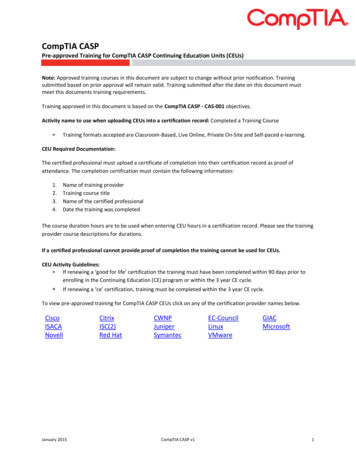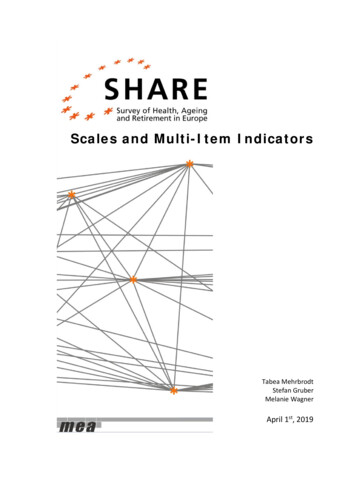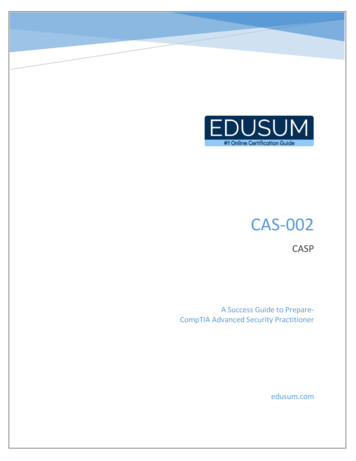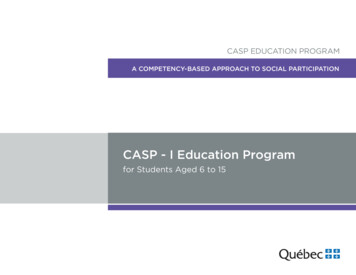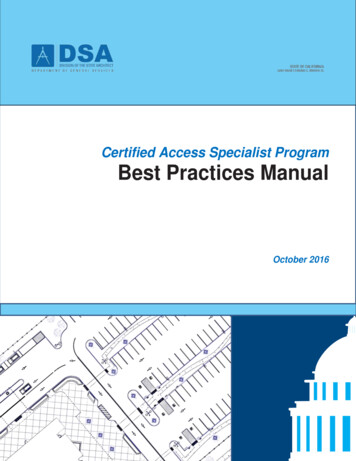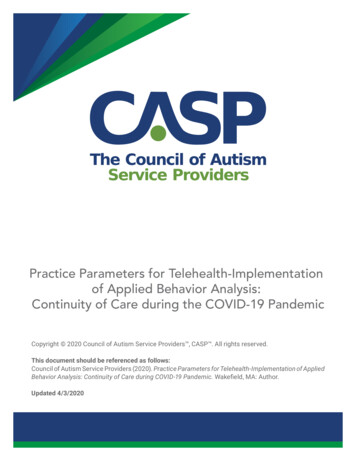
Transcription
PracticeParametersParameters for ionofAppliedBehaviorAnalysis:Applied BehaviorAnalysis:Continuityof Care duringofofAppliedBehaviorAnalysis:of e demicthe COVID-19PandemicContinuityofCareduringPractice Parameters for Telehealth-Implementation ofCOVID-19PandemicAppliedtheBehaviorAnalysis: Continuityof Care duringCopyright 2020 Council of Autism Service Providers , CASP . All rights reserved.the COVID-19 PandemicThis document should be referenced as follows:Council of Autism Service Providers (2020). Practice Parameters for Telehealth-Implementation of AppliedBehavior Analysis: Continuity of Care during COVID-19 Pandemic. Wakefield, MA: Author.Updated 4/3/2020
Practice Parameters for Telehealth-implementation of AppliedBehavior Analysis: Continuity of Care during the COVID-19 PandemicACKNOWLEDGEMENTSThe Council for Autism Service Providers (CASP) expresses their appreciation to the Telehealth TaskForce for their invaluable contributions in the research, writing, and development of these practiceparameters.Telehealth Task ForceChair: Joy S. Pollard, Ph.D., BCBA-D, Behavior Change Institute; Stanford University School of MedicineMembers: (Alphabetical Order)Jenn Chavez, New Mexico Medicaid Assistance DivisionJennifer Dantzler, BCBA, Including Kids, Inc.Katie Franke, Ph.D., BCBA, The Unumb Center for NeurodevelopmentKathleen Karimi, MHA, Behavior Change InstituteLinda LeBlanc, Ph.D., BCBA-D, LeBlanc Behavioral ConsultingJenna Minton, Esq., Minton Healthcare StrategiesRon Oberleitner, MBA, Behavior Imaging SolutionsHeather O’Shea, Ph.D., BCBA-D, ACES 2020, LLC.Michele Silcox, ABA Therapy Billing & Insurance ServicesRebecca Womack, BCBA, BlueSprig PediatricsCASP Leadership:Lorri Unumb, Esq., CEOMike Wasmer, DVM, DACVIM, Vice President of Government Affairs and Special ProjectsThe Council of Autism Service Providers thanks the Association of Professional Behavior Analysts for its professional collaboration and valuable contributions to this document.This publication and related materials are proprietary to The Council of Autism Service Providers(CASP). Permission to use this publication is granted for educational, non-commercial, and informationsharing purposes, provided that CASP’s copyright notice appearing on the publication is not removedor altered. Any use exceeding the foregoing scope requires written permission by CASP, which may begranted on a case-by-case basis. Please direct any request to use CASP proprietary content by emailinginfo@casproviders.org. 2020 The Council of Autism Service Providers. All Rights Reserved. Updated 4/3/20201
Practice Parameters for Telehealth-implementation of AppliedBehavior Analysis: Continuity of Care during the COVID-19 PandemicTable of ContentsIntroduction3Ethical Telehealth Guidance5Telehealth DefinitionsSynchronous Telehealth ModalitiesAsynchronous Telehealth Modalities889Telehealth Service Delivery Models10Telehealth Applications in ABA TreatmentService Delivery ModelsDetermining the Appropriateness of Telehealth ModelsPartial Telehealth Model: In-person Direct Services and Telehealth Clinical DirectionTelehealth Direct ServicesCaregiver-Implemented ServicesCaregiver Training and ConsultationMonitoring Effectiveness of Telehealth Treatment1111111415171819Service-Specific Guidance21Healthcare Claims Reimbursement for Telehealth41Recommendations for Healthcare Funders44AppendicesAppendix A: Appropriateness of Telehealth Decision ToolAppendix B: Telehealth Program Needs AssessmentAppendix C: Risk AssessmentAppendix D: Environmental Assessment & Session Planning ChecklistAppendix E: Caregiver Pre- and Post-Session ChecklistAppendix F: Informed Consent for Telehealth ServicesAppendix G: Funder Resource4646484951545558References62 2020 The Council of Autism Service Providers. All Rights Reserved. Updated 4/3/20202
Practice Parameters for Telehealth-implementation of AppliedBehavior Analysis: Continuity of Care during the COVID-19 PandemicIntroductionApplied behavior analysis (ABA) interventions are the standard of care for individuals with autism spectrum disorders (ASD). Typically delivered in-person, ABA interventions can increase adaptive skills anddecrease maladaptive behaviors in individuals with ASD, including behaviors that may be dangerous tothemselves and others.The coronavirus disease of 2019 (COVID-19) pandemic and measures imposed to curtail its spread havecreated unprecedented challenges to continuity of care for our patients with ASD. Providers need tothoughtfully consider if, and how, to continue ABA services when in-person delivery carries genuine riskto themselves, their staff, their patients, and caregivers. The telehealth service delivery models, hereafterreferred to as ‘Telehealth’, can help ensure continued access to medically necessary treatment duringthe COVID-19 crisis.As the COVID-19 healthcare crisis unfolds, it is essential for healthcare funders to expand telehealthoptions for all medically necessary treatment, including ABA. Some funders have incorporated a varietyof synchronous (i.e., real-time videoconferencing, telephonic) and asynchronous (i.e., store-and-forward,remote patient monitoring) methods to help ensure patients’ continued access to care. As a result, telehealth service delivery options that have not previously been approved by healthcare funders for servicedelivery options may now be available for providers to implement at their clinical discretion.ABA providers are faced with ethical dilemmas amid the COVID-19 crisis when determining how to proceed with patient care. Providers rendering telehealth for the first time, or with new applications, requiretraining and access to technical resources and support to ensure safe, effective telehealth delivery ofABA services (Pollard et al., 2017; Romani & Schieltz, 2017).Therefore, response plans are essential for:1. Ensuring the safety and well-being of patients and staff;2. Maintaining continuity of care for patients;3. Ensuring organization financial viability and continuity of business operations;4. Ensuring proper utilization of resources;5. Supporting the community and community partners during the health crisis 2020 The Council of Autism Service Providers. All Rights Reserved. Updated 4/3/20203
Practice Parameters for Telehealth-implementation of AppliedBehavior Analysis: Continuity of Care during the COVID-19 PandemicPurposeThe purpose of this document is to guide ABA provider organizations in developing critical responseplans to maintain continuity of care for patients with ASD during the COVID-19 crisis. A second purposeis to provide support and resources to payers as they develop their infrastructure and regulations forexpanding access to telehealth services. Telehealth options presented here are not intended to supplantin-person services. Rather, the intended use of this guide is to assist providers with contingency planningto avoid interruption and disruption of services (BACB Code 2.15 Interrupting or discontinuing services;BACB, 2014), while practicing within one’s scope of competence (BACB Code 1.02 Boundaries of Competence; BACB, 2014). Specifically, this document offers providers, payers, and families:1. Guidance on administering ABA assessment and treatment services via both synchronousand asynchronous telehealth modalities to ensure ethical and quality care is maintained.2. Guidance on appropriate and ethical use of health insurance billing codes, decision trees,and tools for determining criteria for patient participation in different telehealth servicedelivery methods.3. Recommendations for evaluating the risks and benefits of telehealth options in order todevelop an individualized service delivery approach for each patient. 2020 The Council of Autism Service Providers. All Rights Reserved. Updated 4/3/20204
Practice Parameters for Telehealth-implementation of AppliedBehavior Analysis: Continuity of Care during the COVID-19 PandemicEthical Telehealth GuidanceThe Behavior Analyst Certification Board’s (BACB) Professional and Ethical Compliance Code (hereafterreferred to as the Code) indicates that the provider’s main responsibility is “to act in the best interestof their clients” (BACB, 2014). Each provider must do that by utilizing an individualized approach thataccounts for all known variables that impact treatment outcomes.Providers should consider information about all variables that impact patient care to determine if modifications to service delivery may be required to ensure continuity of care. This analysis may lead a providerto determine that treatment can continue under a partial telehealth model or needs to be placed on atemporary hold. The priority must remain to maximize the benefits of the services while mitigating riskof harm to the patient and their caregivers.Maintaining Continuity of Medically Necessary ServicesAbundant research documents the efficacy of comprehensive and focused ABA interventions for building adaptive skills and reducing maladaptive behaviors in people with ASD (Harris et al., 1991; Lovaas,1987; Reichow & Wolery, 2009; Reichow, 2012; Weiss, 1999; Wong et al., 2015). In 1999, the SurgeonGeneral of the United States indicated that the thirty years of research demonstrated the efficacy ofapplied behavioral methods in reducing inappropriate behavior and in increasing communication, learning, and appropriate social behavior (United States Surgeon General, 1999). The approval of 8 CPT codesfor adaptive behavior (ABA) services by the American Medical Association’s CPT Editorial Panel at theCategory I level signifies that the services have proved clinically effective and are widely accepted in thehealthcare community. Those codes went into effect January 1, 2019. Respected healthcare societieslike the American Academy of Pediatrics have recommended ABA services for people with ASD (Hymanet al., 2020). Additionally, most commercial and public health plans in the United States now authorizeABA services as medically necessary for thousands of individuals with ASD. It is incumbent on eachprovider to do all they can to preserve their patient’s medically necessary services to ensure their health,safety and continued development of adaptive skills to promote successful functioning (BACB Code 2.15;BACB 2014). In addition to compounding caregiver stress, disruptions in services may place patients atincreased risk for emergency room visits and hospitalizations, leading to increased healthcare costs.Establishing Contingency PlansGiven the threat of abrupt service disruption as result of the COVID-19 pandemic, providers are encouraged to establish contingency plans to ensure continuity of care. Telehealth is a valuable option forproviding continuity of care when environmental variables impede the provider’s ability to be in-personwith their patients. 2020 The Council of Autism Service Providers. All Rights Reserved. Updated 4/3/20205
Practice Parameters for Telehealth-implementation of AppliedBehavior Analysis: Continuity of Care during the COVID-19 PandemicPatient-specific contingency planning will allow the provider to determine the appropriateness of different telehealth modalities to meet patient and caregiver needs. Contingency planning should includean assessment of risk and benefits for continuing care (in-person and/or via telehealth), therapeuticenvironment, and required technology to determine the extent of telehealth integration that is clinicallyappropriate for each patient.Providers are encouraged to openly discuss contingency plans with patients, caregivers, and treatmentteams to obtain the necessary consent in advance of implementation. Providers should also considerincorporating telehealth training for technicians and patients to prepare in advance for disruptions in care.HIPAA - HITECH Enforcement Discretion During COVID-19 Public Health EmergencyAutism service providers are required to comply with the rules and regulations imposed by the HealthInsurance Portability & Accountability Act (HIPAA) and the Health Information Technology for Economicand Clinical Health (HITECH) Act. Organizations practicing telehealth should consider the unique methods by which protected health information (PHI) is transmitted through telehealth and should offertraining to ensure that providers thoroughly understand their legal and ethical responsibilities. Readersshould refer to the CASP Telehealth Guidelines for more information on recommended organizationalsystems and design.The U.S. Department of Health and Human Services (HHS) Office for Civil Rights (OCR) issued a notification on March 17, 2020 encouraging providers to utilize telehealth to serve patients during thecurrent national public health emergency (OCR, 2020). The notification stated that during the emergency,OCR (which is responsible for enforcing certain regulations issued under HIPAA) will not impose penalties for non-compliance with the regulatory requirements under HIPAA rules against covered healthcare providers who are providing telehealth services in good faith during the COVID-19 nationwide public health emergency. Specifically, providers will be allowed to use certain non-HIPAA compliant, non public-facing videoconferencing technologies, such as some popular applications that are listed in thenotification, as long as they take all precautions to protect the privacy of patient information.Telehealth Modalities: Support and LimitationsThis guide provides an in-depth description of the ways that ABA services can be delivered via telehealth.Telehealth has been employed for almost two decades in the delivery of ABA assessment and treatment to individuals with ASD and training of caregivers in the assessment and delivery of ABA services(Barretto et al., 2006; Ferguson et al., 2019). Telehealth has proven to be a useful and effective vehiclefor training caregivers and technicians to implement ABA services (Barretto et al., 2006; Boisvert et al.,2010; Ferguson et al., 2019; Fisher et al., 2014; Lindgren et al., 2016; Tomlinson et al., 2018; Vismara et al.,2009). Remote delivery of ABA services and training allows for continuity of care while eliminating therisk for transmission of COVID-19. 2020 The Council of Autism Service Providers. All Rights Reserved. Updated 4/3/20206
Practice Parameters for Telehealth-implementation of AppliedBehavior Analysis: Continuity of Care during the COVID-19 PandemicIt is important to note that not all telehealth modalities for ABA service delivery are supported by extensive research at this point in time. There is, however, extensive scientific evidence for the efficacy ofmany ABA services delivered in-person (LeBlanc et al., 2014; Reichow & Wolery, 2009; Wong et al., 2015),and at least preliminary evidence that a number of those services can be delivered directly to patientsvia telehealth (Myers et al., 2017), and that caregivers can be trained via telehealth to deliver services topatients in-person (Bearss et al., 2018; Benson et al., 2018; Higgins et al., 2017; Monlux et al., 2019; Suesset al., 2014). This guide is informed by both of the foregoing sources of evidence, as well as professionalstandards for the delivery of ABA services and practice parameters and guidelines from the Council ofAutism Service Providers, American Telemedicine Association, and American Academy of Child andAdolescent Psychiatry (Myers et al., 2017; Myers & Cain, 2008). Clearly, additional research is warranted.Limitations of this DocumentThis guide is designed to aid provider agencies in decision-making that is consistent with the best currently available scientific evidence and clinical consensus. The ultimate judgement regarding patientcare must be made by the provider, taking into consideration the assessed needs, strengths, and preferences of each patient and their caregivers as well as available resources. 2020 The Council of Autism Service Providers. All Rights Reserved. Updated 4/3/20207
Practice Parameters for Telehealth-implementation of AppliedBehavior Analysis: Continuity of Care during the COVID-19 PandemicTelehealth DefinitionsTelehealth is defined by the Health Resources and Services Administration (HRSA) as the “use of electronic information and telecommunication technologies to support and promote long-distance clinicalhealth care, patient and professional health-related education, public health and health administration”(Health Information Technology, 2017).Telehealth is a means of delivering health care, not a separate or distinct healthcare service. It is a service delivery model that allows providers to deliver the healthcare service directly to the patient, withoutrequiring the patient to travel to receive care. In-person is defined as real-time patient/provider interactions occurring with both individuals present in the same room.On-site is defined as immediately available and interruptible, which can be met via synchronous telehealth methods.Face-to-face is defined as real-time patient interactions occurring either in-person or viatwo-way audio and visual video conferencing.Synchronous Telehealth ModalitiesSynchronous telehealth methods include interactive audio and/or video connections that transmit information in both directions during the same period of time (American Telemedicine Association, 2017).Face-to-face encounters refer to the patient and provider engaged in real-time clinical interactions andthe definition is met when the providers are using synchronous real-time audio and/or visual telehealthtechnology (CMS-2348-P, 2011). Real-time videoconferencing consists of face-to-face provider and patient interactionsthat occur in real-time via a two-way video and audio interactions.Telephonic e-visits consist of real-time voice conversations with the patient or family viaa two-way audio interaction. 2020 The Council of Autism Service Providers. All Rights Reserved. Updated 4/3/20208
Practice Parameters for Telehealth-implementation of AppliedBehavior Analysis: Continuity of Care during the COVID-19 PandemicAsynchronous Telehealth ModalitiesAsynchronous telehealth methods include transmission of electronic health information, such as video,data, or other health information to a provider at another site for later review. Transmissions typicallyoccur during separate time frames, rather than simultaneous interactions (American Telemedicine Association, 2020).Asynchronous telehealth tools enable patients and providers to connect outside of in-person settingsand traditional face-to-face appointments, thus making it easier for patients with transportation, scheduling barriers, or compromised immune systems to access care on an on-going basis. Asynchronoustelehealth methods are medically necessary transmissions that require clinical decision making and arenot for administrative or scheduling purposes. Store-and-forward video includes transmission of video and audio interactions to a provider at another site.Remote patient monitoring includes the use of electronic tools to record personal healthinformation in one location and transmitting data to a provider at another location, typically at another time (Health Information Technology, 2017). 2020 The Council of Autism Service Providers. All Rights Reserved. Updated 4/3/20209
Practice Parameters for Telehealth-implementation of AppliedBehavior Analysis: Continuity of Care during the COVID-19 PandemicTelehealth Service Delivery ModelsPartial Telehealth Model:In-person DirectServices& Telehealth ClinicalDirectionWhenever possible, services should be delivered in-person by eithera behavior analyst or technician. Clinical decisions should be basedon the behavior analyst’s assessment of the needs, strengths, andpreferences of each patient and their caregivers.Organizations may employ a partial telehealth model in which atechnician delivers services in-person with the patient and the behavioranalyst provides clinical oversight remotely via synchronous orasynchronous modalities. This model could allow continuation of apatient’s current focused or comprehensive ABA treatment program atthe recommended dosage or a partial reduction in dosage.Telehealth DirectServices & TelehealthClinical DirectionIf the patient has the prerequisite skills (see below), services may bedelivered to them directly via synchronous modalities. This modelcould allow continuation of a patient’s treatment program at therecommended dosage or a partial reduction in emented services may be appropriate if the patient orother members of the household is immunocompromised or if thecaregiver prefers to reduce contact with other individuals. This modelcould allow the caregiver to continue to implement protocols on whichthey have been trained, or to be coached by a technician to implementnew or modified protocols with the patient.This model could allow the patient to receive a reduced level ofservices, perhaps focused on practicing or developing adaptivebehaviors or maintaining daily routines in order to prevent regression,maintain functioning, and/or reduce occurrences of maladaptivebehaviors.Caregiver ConsultationsCaregivers who are not able to deliver services directly to patientsmay benefit from caregiver training and consultation with the behavioranalyst on strategies to prevent regression by the patient and reducethe likelihood of crisis situations. Alternatively, or additionally, thebehavior analyst might train caregivers to implement a small subset ofprotocols that are deemed high priority and within the caregivers’ skillsand capacity. This model focuses on antecedent interventions, crisisprevention, and problem-solving individual concerns with the caregiver. 2020 The Council of Autism Service Providers. All Rights Reserved. Updated 4/3/202010
Practice Parameters for Telehealth-implementation of AppliedBehavior Analysis: Continuity of Care during the COVID-19 PandemicTelehealth Applications in ABA TreatmentService Delivery ModelsTelehealth can be delivered using any of the models described above along with any combination ofsynchronous and/or asynchronous modalities. ABA providers should evaluate the risks and benefitsassociated with each telehealth model for ABA service delivery. They should use their clinical judgmentbased on the characteristics of each patient and their caregivers to ensure that the selected modeland delivery modalities lead to meaningful patient interactions. Providers must also document that thepatient and/or their caregiver has the skills required to participate in a meaningful way with telehealthservices. The services and the clinical effects of those services should be carefully documented in thepatient’s medical record.Determining the Appropriateness of Telehealth ModelsDetermination of whether a patient and their caregivers can participate productively in one of the modelsfor telehealth ABA services should be based on the patient’s characteristics, their individualized treatment plan, their caregivers’ ability to participate in sessions (if necessary), and technological requirements (Appendix A: Appropriateness of Telehealth Decision Tool).Patient CharacteristicsThe skills required for each patient to participate in telehealth depend on their treatment goals and thetelehealth service delivery model being implemented. Those skills will be different for a patient for whoma behavior analyst or technician will deliver services via synchronous, real-time videoconferencing and apatient for whom services will be delivered in-person by a caregiver. Providers will need to assess whetherthe patient has the appropriate prerequisite skills to participate in the different telehealth models.Individualized Treatment PlanProviders should evaluate the patient’s individualized treatment plan to determine if the patient’s goalsand objectives are suitable for telehealth. Providers should evaluate modifications that may be needed tothe goal and objectives, for the reinforcement systems and delivery mechanisms, prompting procedures,and materials for each program (Appendix B: Telehealth Program Needs Assessment). Location of materials and caregivers’ access to materials required to implement assessment and treatment protocolsshould be specified. A materials inventory may be useful for determining available resources and guiding caregiver-provider communication, reducing the potential for service interruption due to inadequateaccess to materials. 2020 The Council of Autism Service Providers. All Rights Reserved. Updated 4/3/202011
Practice Parameters for Telehealth-implementation of AppliedBehavior Analysis: Continuity of Care during the COVID-19 PandemicAs part of the treatment plan evaluation, it is recommended that providers assess whether the environment is conducive to safe and beneficial delivery of services via telehealth. Notably, a significant portion of the research literature is specific to the assessment and treatment of severe problem behavior(Lindgren et al., 2016; Monlux et al., 2019; Suess et al., 2020; Suess et al., 2016; Wacker, Lee, Dalmau,et al., 2013, 2013; Wacker, Lee, Padilla Dalmau, et al., 2013). Therefore, the presence of severe problembehavior should not be an exclusion criterion for telehealth services (Appendix C: Risk Assessment).Rather, providers should assess environmental safety risks for the patient, as well as any direct care staff(Appendix D: Environmental Assessment and Session Planning Checklist).Organizations should have protocols in place for addressing environmental modifications that may beneeded to support the safe delivery of telehealth services. Consideration should be given to caregivers’ability to modify the environment, such as removing objects that may pose risk of injury to the patient orcaregivers (Appendix D). Caregivers may need protective equipment and/or guidance in using commonhousehold items to ensure safety (e.g., pillows to block aggression, long sleeves to prevent injury due topinching or biting) (Monlux et al, 2019). That may require mailing safety equipment to the caregivers and/or providing them with written, verbal, or model instructions for using protective equipment and clothing.Caregiver’s Ability to Participate in SessionAssessment of caregivers’ ability to participate in service delivery should consider the time they can beavailable, other individuals for whom they may be responsible, and any physical restrictions. Providersshould carefully review all requirements for preparation of the session location, technology, materials,as well as a post-session tasks (e.g., charging technology) (See Appendix E: Caregiver Pre-and Post-Session Checklist).Informed consent should be sought for the patient’s participation in telehealth services. The consentdocument should provide a clear description of the benefits and risks involved and any other informationrequired to enable patients and caregivers to make fully informed decisions on telehealth services. Thisshould include a description of the technology and procedures that will be involved, what to expect fromthe telehealth encounters, and what is known about each telehealth modality from research. Consentshould be sought for each modality and service provided. For example, a caregiver may provide consentfor store-and-forward modalities for clinical consultation, but not for the use of video to train organization staff (see Appendix F: Informed Consent for Telehealth Services). 2020 The Council of Autism Service Providers. All Rights Reserved. Updated 4/3/202012
Practice Parameters for Telehealth-implementation of AppliedBehavior Analysis: Continuity of Care during the COVID-19 PandemicTechnology RequirementsPrior to initiating telehealth services, the provider should assess whether the environment will supporttelehealth service delivery. For example, providers will have to determine if patients and the individualswho will assist them in participating in telehealth services have access to a secured internet connectionand required technology (both hardware and software). The CASP Telehealth Guidelines provide guidance on the technology requirements for telehealth sessions (CASP, 2020).In addition, space must be arranged where the patient and caregivers are within view of any camerasused for remote observation and clinical direction by the behavior analyst or technician (Appendix D).Additional equipment (e.g., iPad mounts) may be required to optimize their view. Ideally, the environmental arrangement should allow the patient to move freely within and across areas within the treatmentsetting. Careful placement of the camera will facilitate remote observation of sessions with minimalinterruption. 2020 The Council of Autism Service Providers. All Rights Reserved. Updated 4/3/202013
Practice Parameters for Telehealth-implementation of AppliedBehavior Analysis: Continuity of Care during the COVID-19 PandemicPartial Telehealth Model: In-person Direct Servicesand Telehealth Clinical DirectionResearch has shown that ABA services can be rendered in-person by a technician or caregiver, withclinical oversight provided by a behavior analyst via telehealth (i.e., partial telehealth model), for functional behavior assessments (Barretto et al., 2006; Benson et al., 2018; Boisvert et al., 2010), preferenceassessments (Higgins et al., 2017), behavior reduction procedures (Lindgren et al., 2016; Suess et al.,2016; Wacker et al., 2013; Wacker et al., 2013), and interventions to build language, social, and daily livingskills (Barkaia et al., 2017; Ferguson et al., 2019; Ingersoll et al., 2016; Wainer & Ingersoll, 2015). The CASPOrganizational Guidelines and Standards (Telehealth chapter) describes con
Apr 03, 2020 · (CASP). Permission to use this publication is granted for educational, non-commercial, and information sharing purposes, provided that CASP’s copyright notice appearing on the publication is not removed or altered. Any use exceeding the foregoing scope requires written permission by CAS
